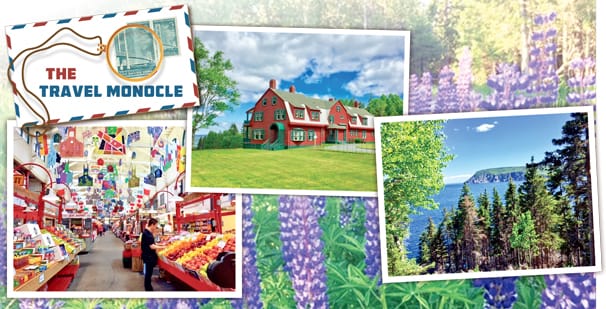The Canadian Maritimes Part 2 of 2

Left to right. City Market in St. John, N.B. Great place to find most anything, including lunch. Roosevelt Cottage, Campobello Island, N.B. Middle Head Hike, Cape Breton National Park, N.S.

Article and photos by Joe Gschwendtner
Part two features the large southern provinces, New Brunswick and Nova Scotia. Should you have more time, consider pastoral, Scotland-like Prince Edward Island. The Confederation Bridge to get there is eight miles long, an attraction itself.
Motoring from the U.S. is a long journey. Ferries offer a bypass to Yarmouth, Nova Scotia but one skips New Brunswick. Flying into Halifax and renting a car is another option. We’ve done it both ways; this was the auto route allowing greater appreciation of New Brunswick.
Entering New Brunswick, we enjoyed Campobello Island, Franklin Roosevelt’s family retreat. The 34-room Roosevelt Cottage offers fascinating insights on the man himself and presidential history. Hiking options add extra value to this leafy international park. Further east is St. Andrews, an exquisitely picturesque Atlantic Coast village and well worth your time.
We visited two other New Brunswick cities: Fredericton – the capital, and St. John. Both were inviting, Fredericton having idyllic appeal. There, the St. John River winds its way lazily along the northern periphery. Queen Street showcases many restaurants (our favorite: the 540 Kitchen and Bar), shops, and government buildings: the old in the Garrison District and the new, not far away. The Urban Walk was a highlight that included passage on an old railroad trestle and many manicured paths. St. John, much bigger, offers a visit to a working port city. It is hilly and walkable, with breathtaking cliffs and rapids. Browse the City Market.
The principal attraction, further north, is Bay of Fundy National Park, where tides of one billion tons move as much as 45 feet in 12 hours. Spectacular visuals, hiking trails, and canoeing opportunities abound. Don’t miss it!
Most of your lower Maritimes trip should be invested in Nova Scotia. Terrain is varied and stunning, attractions everywhere. Imbibe in its heritage: four jiggers of British Isles and one shot of French Acadian.
Halifax has panache. Make time for it. Denver-sized, fresh and airy, it has a redeveloped waterfront chock full of art, people and tantalizing cuisine. Within the city are fascinating museums, most notable the Immigration and Maritime collections (including the mind-boggling story of the world’s greatest non-nuclear explosion, a munitions ship harbor collision that leveled Halifax).
Hopscotching around Nova Scotia takes careful planning. The southwest shore offers extraordinary seascapes, especially near Peggy’s Cove and the much-photographed Lunenburg area. We then chose to spend our remaining time on Cape Breton Island, finding a potpourri of attractions natural and man-made:
– Judique’s Celtic Music Center: remarkable entertainment!
– Cape Breton National Park: Rugged beauty. Favorite hikes: La Chemin de Butterau, Skyline (possible moose sightings), and Middle Head.
– Aucoin Bakery: Cheticamp.
– Baddeck: Lobster dinners, Alexander Graham Bell Museum (communication and aviation pioneer).
– Louisbourg Fortress (Sydney): Original French Fort (1719-1745). Taken via siege by British. Staffed by actors who bring the community alive. (Built by government workfare program when local coal mines closed).
Nova Scotia alone is a breathtaking vacation venue – two islands. The depth of your enjoyment depends on the success of your game plan. Don’t leave home without one.